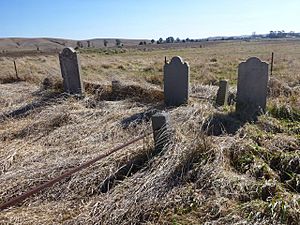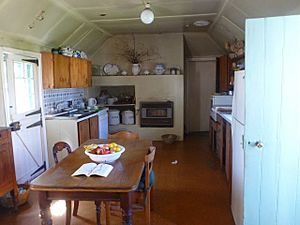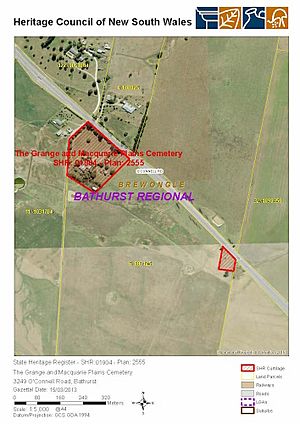The Grange and Macquarie Plains Cemetery facts for kids
Quick facts for kids The Grange and Macquarie Plains Cemetery |
|
|---|---|

North facade of Grange farmhouse facing courtyard with cottage on left (east) and kitchen wing on right (west)
|
|
| Location | 3249 O'Connell Road, Bathurst, Bathurst Region, New South Wales, Australia |
| Built | 1830–1836 |
| Architect | Vernacular |
| Official name: The Grange and Macquarie Plains Cemetery; Macquarie Plains Cemetery | |
| Type | state heritage (complex / group) |
| Designated | 15 March 2013 |
| Reference no. | 1904 |
| Type | Homestead Complex |
| Category | Farming and Grazing |
| Builders | Vernacular - probably convict labour |
| Lua error in Module:Location_map at line 420: attempt to index field 'wikibase' (a nil value). | |
The Grange and Macquarie Plains Cemetery are important historical sites in Bathurst, Australia. The Grange is an old farmhouse, and the Macquarie Plains Cemetery is a historic burial ground. Both are located on O'Connell Road. The farmhouse was built between 1830 and 1836. It was likely constructed by people who were convicts at the time. These sites are so important that they were added to the New South Wales State Heritage Register on March 15, 2013.
Exploring the History of The Grange
First People of the Land
The land around the Blue Mountains, where Bathurst is located, has been home to Aboriginal people for at least 12,000 years. The Wiradjuri people lived in the Bathurst area before Europeans arrived. They moved around in small groups, following the seasons. They often camped near the Macquarie River because it provided lots of food.
When Europeans first explored west of the Blue Mountains in 1813, the Wiradjuri people resisted. This led to some conflicts. By 1840, the traditional way of life for Aboriginal people was greatly changed. This was made worse after 1850 by the gold rush in the region.
European Settlement Begins
After the Blue Mountains were crossed in 1813, Europeans began exploring the Bathurst area. Assistant Surveyor George Evans was one of the first to explore the Bathurst Plains in 1813. Bathurst then became a starting point for many expeditions.
Between 1814 and 1815, the first road across the Blue Mountains to Bathurst was built. It was constructed by William Cox and his team of convict workers. This road, known as Cox's Road, passed about one kilometre south of where The Grange is today.
Over time, new roads were built that were easier or shorter. A new official route was surveyed in 1823. This route crossed the Fish River at O'Connell and went through Kelso to Bathurst. The current Bathurst-O'Connell Road, which cuts through The Grange property, was built in 1860.
Land Grants and Early Farms
When British rule expanded beyond the Blue Mountains in 1815, the system of land ownership changed. The land was considered to belong to the Crown (the government). It was then given to settlers through land grants. Governor Macquarie controlled these land grants strictly.
Only a few large land grants were given out during Governor Macquarie's time (1810-1821). These included grants to people like William Cox and William Lawson, who helped open up the area. Smaller grants were also given to ten other settlers in the Kelso area in 1818.
The Story of The Grange Farmhouse
In 1821, Governor Macquarie gave land grants to two brothers, Thomas and John West. Each brother received 600 acres of land. John West started The Grange, and Thomas West started Westham nearby. Both brothers built similar Georgian-style farmhouses. The Grange farmhouse is still standing and is very well preserved.
In 1822, Governor Brisbane encouraged more settlers to apply for land. This led to many new farms being set up on Wiradjuri land. In 1824, the Wiradjuri people, led by Windradyne, tried to fight back against this expansion. However, their resistance was put down by soldiers in Bathurst.
Some early farmers became very successful. They built large homesteads, adding rooms and wings as their wealth grew. The Grange is a great example of an early Georgian homestead. It looks much like it did when it was first built. These homesteads provided homes for the farmers, their families, and their workers, including convicts before the 1840s.
John West built the original farmhouse around 1830. He likely used convict workers assigned to him. The house was made of brick with a timber shingle roof and a verandah. John West is believed to have named it The Grange. His brother Thomas built a similar farmhouse called Westham around the same time.
A brick cottage was built next to The Grange farmhouse in 1836. In 1860, a new road to O'Connell was built, which split the property.
In 1920, the original 600-acre land grant was divided into three smaller lots. The West family kept the lot with The Grange farmhouse. The other two lots were sold.
The West family used The Grange for farming for four generations. In 1955, they sold it to Edward Rooke. The property changed hands a few more times. In 1972, Edward and Lorraine Jones bought it. The buildings were in poor condition then, but the Jones family has slowly restored them.
Who Lived at The Grange?
Here's a quick look at some of the people who lived at The Grange:
- 1819: John West and his family received permission to move to the colony from England. His brother Thomas and his family also got permission.
- 1821: John West, his wife Martha, and their children arrived in Sydney. John West was granted 600 acres of land in Bathurst.
- 1825: John West and his family lived in Bathurst town before The Grange was built.
- 1849: John West passed away in Bathurst.
- 1930: Charles James West (John West's grandson) lived at The Grange with his family.
- 1935: Charles James West passed away.
- 1936: Leslie Charles West and Arthur Thompson West (John West's grandsons) lived at The Grange with their sister Amy Ellen.
- 1945: Edward Rooke started working as a share farmer on The Grange property.
- 1955: Arthur Thompson West passed away. Edward Rooke bought The Grange from his estate.
- 1965: Mrs. Freeda Moore bought The Grange from Mr. Rooke.
- 1972: Edward and Lorraine Jones bought The Grange from Mrs. Freeda Moore's estate.
The Macquarie Plains Cemetery
Around 1844, John West gave about two-thirds of an acre of land to the Methodist Church. This land was used to build a small church and a cemetery. The cemetery seems to have been used first in 1837 and stopped being used in 1896. The first known burial was Eliza Hall in 1837. There are at least 22 graves there. The timber church was taken down in 1920. In 1997, Edward and Lorraine Jones bought the cemetery land back from the Uniting Church of Australia.
What The Grange Looks Like
The Grange is located about 12 kilometres southeast of Bathurst. The property listed as heritage includes 28 hectares of land. This land is part of the original 600-acre grant given to John West around 1821.
Gardens and Grounds
The gardens around the main house are not original. The current owners have planted most of them since 1972. However, a gum tree at the entrance gate on O'Connell Road is very old and important. There's also an old poplar tree on the western side of the kitchen area.
The rest of the land around the homestead has been used for sheep farming for a long time. You can still see old farm buildings like sheds made of corrugated iron and timber, fences, and sheep yards.
The Cemetery Site
The cemetery is on the land John West gave to the Methodist Church in 1844. It is about 500 metres south of The Grange farmhouse. A small wooden Methodist church used to be there but was removed around 1920. Now, only the old graves remain.
The graves belong to local families from the Macquarie Plains area, including some members of the West family. They date from 1837 to 1896. In 2006, 22 grave inscriptions were recorded online. Some local people believe that many children were buried here in unmarked graves during a scarlet fever outbreak in 1876.
The Homestead Buildings
The homestead includes the main Georgian farmhouse, built around 1830. There's also a kitchen-garage wing and a cottage wing, built around 1836. Both wings are now connected to the main house. They form a courtyard entrance area that faces O'Connell Road.
The original farmhouse has a verandah that used to go all the way around the house. This verandah is thought to be one of the earliest wrap-around verandahs in Australia. Parts of the verandah have been enclosed to create new rooms. The walls of the farmhouse are made of rendered brickwork. The original windows are timber-framed with small glass panes. The main entrance, which used to face the river to the south, has a formal look with a central door. The original timber shingles for the roof are believed to still be under the corrugated iron roof. The hallway inside the farmhouse is still very much like it was originally.
Because John West had several male convicts working for him when the homestead was built, it's believed that convicts did the construction. The house was originally designed to face the old road to the south. But when the new O'Connell Road was built in 1860 to the north, the house's entrance was changed to face that road.
The Kitchen
The kitchen was originally a separate building, probably built around the same time as the main farmhouse. The cottage, built around 1836, was made with bricks produced by hand.
Condition and Changes Over Time
The Grange farmhouse still has its original shape and much of its original structure. However, some internal rooms have been changed, and rooms have been added to the verandah corners. There is some dampness in the bedrooms on the northeast side.
The cottage still has its original outer walls but has been extended to include a new kitchen and bathroom. What was once a tack room (for horse equipment) is now a sitting room. The bedrooms on the southwest side of the cottage are still in their original layout.
The cemetery is old and has not been restored. Some of the gravestones have been repaired, but others are in surprisingly good condition for their age. Records of the graves are available online.
Over the years, The Grange has been changed by its different owners:
- Around 1860, the new O'Connell Road was built, changing the main entrance of the house to the north.
- Around 1880, a wall between the sitting and dining rooms was removed to create one large living room. The fireplace was also moved.
- A bathroom was added around the 1920s by using part of the verandah.
- The kitchen wing, which was once separate, was connected to the main house before 1900.
- In 1965, the timber floor in the kitchen was replaced with cement.
- In 1972, an old sulky shed (for horse-drawn carts) collapsed. This area is now a garage.
- In 1975, the kitchen was renovated, and the old wood-fired stove was removed.
- In 1980, an outdoor room was added to the house.
- In 1998, a window was replaced with French doors.
- The cottage was partly rebuilt in 1973. A new brick extension was added to the western side, including a kitchen, lobby, and bathroom. The bricks for this extension came from an old bank building in Bathurst.
Why The Grange is Important
The Grange is very important because it's one of the oldest surviving farmhouses built in inland Australia. The West family were pioneers in the Bathurst area. John West's farmhouse, built in 1830, is beautiful with its wrap-around verandah, which might be the oldest of its kind in Australia. The house also shows us what early colonial life was like, especially for the convicts who worked there.
The historic Methodist cemetery, used from around 1855 to 1896, is also a significant part of the site. It's an important reminder of the early settler families in the area, and it includes graves of the West family.
The Grange and Macquarie Plains Cemetery were added to the New South Wales State Heritage Register on March 15, 2013, because they meet several important criteria:
- Historical Significance: The Grange shows the history of early settlement in New South Wales. It's one of the first homes built inland, likely by convict labour. The cemetery also tells the story of early colonial times.
- Association with Important People: The Grange is linked to Governor Macquarie, who made only a few land grants west of the Blue Mountains. It's also connected to the building of the first roads to Bathurst and to the pioneering West family.
- Architectural Beauty: The Grange is a great example of a colonial Georgian farmhouse, known for its balanced and well-designed look. Its wrap-around verandah from 1830 is considered one of the first in Australia.
- Community Connection: Many people in the Bathurst area see The Grange as a strong reminder of early European settlement and colonial life.
- Research Potential: The Grange could provide valuable archaeological information about the colonial and convict history of New South Wales.
- Rarity: The Grange is rare because it's a very well-preserved example of an early Georgian colonial farmhouse. The cemetery is also a rare surviving community burial site for early settlers.
- Representative Example: The Grange is a good example of a colonial Georgian homestead, likely built by convicts on an early land grant.







